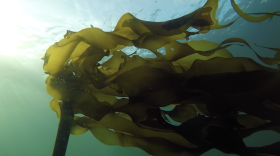Representatives from the Alaska Fisheries Development Foundation visited Unalaska last week as part of its push to expand the state's mariculture industry.
Gov. Bill Walker created the Alaska Mariculture Task Force in 2016. Since then, the organization has been focused on developing the state's mariculture industry to meet its long-term goal of $100 million by 2038.
Mariculture refers specifically to farming and enhancing shellfish and seaweeds, and does not include farming finfish like salmon, which is illegal in Alaska. The state's mariculture industry was valued at approximately $1 million in 2018.
Julie Decker, executive director of the Alaska Fisheries Development Foundation, sees opportunities in the shorelines and beaches of the Aleutian coast.
"You have lots of water, so you have lots of space. Relatively little population which means relatively little conflict," Decker said. "The people that do live here are used to working on the water. There's North America's largest processing port. These are some pretty significant assets."
Oyster and kelp farms have been springing up in Alaska's coastal communities, from Southeast Alaska to the Kenai Peninsula and Kodiak Island, but there's only been one permit so far in the Aleutians.
Decker says that a lot of the infrastructure from the fishing industry could be used to expand mariculture in the Aleutians, and that people could reconfigure much of their fishing equipment. And while shellfish could do well in the Aleutians, Decker says seaweed offers an easier point-of-entry.
Seaweed provides a quicker return than most shellfish because it is an annual crop, unlike oysters, for example, which can take about three years to harvest. That's not to say mussels, oysters or sea cucumbers wouldn't thrive here, but kelp happens to time well with the fisheries already in place.
Industry experts say the timing for kelp farming fits well between pollock or salmon seasons.
"You want to have your kelp out of the water by the beginning of June," said Tamsen Peeples, a commercial seaweed mariculture specialist whose job is to counsel businesses and investors interested in mariculture. "And guess what else happens at the beginning of June: the salmon come back."
Peeples says growing kelp also offers environmental benefits. "Seaweeds are carbon negative, because they do draw carbon out of the ecosystem. And if you're familiar with ocean acidification, that can have huge ramifications and benefits for the ocean, as well as just the entire global environment," she said.
It also provides economic opportunities for kelp farmers to sell carbon credits.
Countries like Norway, France and Chile are competing with Asian nations for the seaweed market, while the United States largely sits on the sidelines, she said.
"We're one of the only large countries in the world that's not producing or harvesting wild seaweeds," Peeples said, "so we're a little bit behind the curve."
A United Nations report valued the global seaweed industry at over $6 billion in 2018. And while Alaska may be a global leader in fishing, the state falls behind in mariculture.
By comparison, aquaculture in New Zealand — which does include finfish farms — generated over $450 million in 2020.
Decker says growing Alaska's mariculture into an operation on a competitive scale won't be easy. "I want to be clear with people that when you're developing something new, there's always challenges."
For new farmers, those difficulties may include picking farm sites and navigating the application process. But Peeples says that she is available specifically for those purposes. "I would be assisting with site selection, as well as business planning and the permit process and then application assistance," she said.
Decker and Peeples also say there are various funding opportunities available, including the Mariculture Revolving Loan Fund.
Alaska Fisheries Development Foundation's website has more information about mariculture training and funding opportunities. There are also pamphlets and other materials available at the Unalaska Visitors Bureau.






